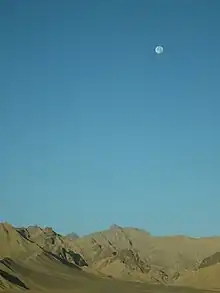Datong horse
The Datong horse (simplified Chinese: 大通马; traditional Chinese: 大通馬; pinyin: Dàtōng mǎ) is a breed of pony native to northern Qinghai province, China. It is best known for its relationship with the famous dragon horse in Zhou Muwang's biography, who held it in very high esteem. The Datong is a sturdy pony, perfectly adapted to life at altitude. Like many other Chinese horse breeds, its population is in decline.
| Country of origin | Qinghai, China |
|---|---|
| Use | Saddle horse and farm work |
| Traits | |
| Weight |
|
| Height |
|
| Color | Bay, chestnut, black, sometimes grey |
History

The Datong's origins can be traced back over 4,000 years.[1] The breed originated in a high-altitude biotope, at around 2,400 m, around the Datong drainage basin[2] in northern Qinghai province.[1] In the 19th century, Hequ horses were imported from southern Qinghai to northern Qinghai, to be crossed with the Datong to improve it.[3] This increased the size of the breed.[4] From 1934 onwards, some Datongs were crossed to produce the Shandan breed.[5] The Food and Agriculture Organization (FAO) lists 60,000 Datong animals in 1980.[2]
Relationship with the "dragon horse"
This breed is famous in China and the rest of the world for its connection with the famous "dragon horse" mentioned in the biography of Zhou Muwang, between 982 and 1023 BC.[1] The dragon horse is an animal of great power and exceptional endurance, which suddenly appeared during the reign of Mu. Chinese art and chronicles contain numerous references to King Mu's eight horses, capable of covering 1,000 li per day, or 400 km daily.[1] This is a figure of speech for horses of exceptional endurance, capable of long journeys without fatigue.[1] The dragon horse is characterized by small bony protuberances on the head, just above the eyes, which could pass for small horns.[1]
These horses were considered sacred by the Emperor's court, who saw them as gifts from heaven. The dragon horse is mentioned in a bamboo book from the Sui dynasty.[1] It tells of the capture of dragon-horse mares in Qinghai.[1] Over time, references to the dragon horse would have been forgotten, and breeders would have eliminated horses with bony protuberances, considering them an anomaly.[1] The relationship between the Datong and the dragon horse is a controversial subject in China and the rest of the world, with many specialists believing that horned horses are nothing more than a myth.[1]
Description
According to Bonnie Lou Hendricks of the University of Oklahoma, the average height varies between 1.24 m and 1.35 m, but the breed's best subjects exceed this height.[1] The FAO gives an average of 1.26 m for females and 1.31 m for males, with average weights of 271 and 321 kg respectively.[2] The average birth weight of females is 38 kg.[2]
There are two types, light and heavy.[1] The light pony[2] is a coarse, compact-looking pony, very strong and muscular.[4] The back is long, but as a whole is harmonious.[4] The head is heavy, of medium length, broad in the cheeks, with a straight or "rhinoceros" profile.[4] The ears are of medium length, with open nostrils.[4] The neck is short, thick and muscular, not very well connected to the withers, which are fairly flat.[4] Chest deep, ribs well rounded, abdomen elongated.[4] The rump is short and sloping.[4] The medium-length legs are covered with feather along the entire length of the barrel.[4] The joints and hooves are very strong.[4] The hocks are slightly closed.[4] The mane and tail are thick and abundant.[4]
The light Datong has a drier head, longer limbs and a more refined muzzle than the heavy type, and is reputed to be strong and lively.[4] The Datong's temperament is considered good.[4] Trotters and gaited can be found in the breed.[4] The Datong is also renowned for its exceptional endurance, particularly at high altitudes,[4] up to 3,500 m.[2]
The coat is bay, chestnut, black, or sometimes gray or, even more rarely, leopard complex.[4] White markings are possible on the head and lower limbs.[4]
Genetic studies have determined that this breed belongs to the Qinghai and Tibetan Plateau horse group, of which the Datong is a member along with the Hequ, Chaidamu and Yushu.[6][7]
Usage
The Datong is used for agricultural work,[4] especially as a packhorse.[2] They are also bred for meat.[8]
Spread of breeding
The Datong is one of China's native horse breeds, originating in northern Qinghai to be precise.[9] In 2005, Datong ponies numbered between 20,000 and 23,024 head.[2] According to the FAO's 2007 assessment, this horse was not threatened with extinction.[10] The threat level is now (2019) indicated as unknown on DAD-IS.[2]
References
- Hendricks (2007, p. 153)
- "Datong / China (Horse)". Domestic Animal Diversity Information System of the Food and Agriculture Organization of the United Nations.
- Hendricks (2007, p. 216)
- Hendricks (2007, p. 154)
- Hendricks (2007, p. 368)
- "Investitute of animal science, Beijing : Evaluation of the genetic diversity and population structure of Chinese indigenous horses using 27 microsatellite markers". Issues in Animal Science and Research: 2012 Edition. ScholarlyEditions. 2013. ISBN 978-1481646222.
- Ling, Yinghui; Ma, Yuehui; Guan, Weijun; Cheng, Yuejiao (2010). "Identification of Y Chromosome Genetic Variations in Chinese Indigenous Horse Breeds". Journal of Heredity. 101 (5): 639–643. doi:10.1093/jhered/esq047. ISSN 0022-1503. PMID 20497969. Retrieved 4 October 2015.
- Rousseau (2014, p. 346)
- Hendricks (2007, p. 153)
- "Breeds Currently Recorded In The Global Databank For Animal Genetic Resources" (PDF). Organisation des Nations Unies Pour l'Alimentation et l'Agriculture: 27. 2007.
Bibliography
- Rousseau, Élise (2014). Tous les chevaux du monde (in French). Delachaux et Niestlé. ISBN 978-2-603-01865-1.
- Hendricks, Bonnie (2007). International Encyclopedia of Horse Breeds (2nd ed.). University Oklahoma Press. ISBN 978-0-8061-3884-8. OCLC 154690199.
- Porter, Valerie (2002). "Datong". Mason's World Dictionary of Livestock Breeds, Types and Varieties. CABI. ISBN 085199430X.
- Porter, Valerie; Alderson, Lawrence; Hall, Stephen; Sponenberg, Dan (2016). Mason's World Encyclopedia of Livestock Breeds and Breeding (6th ed.). CAB International. p. 460. ISBN 978-1-84593-466-8.